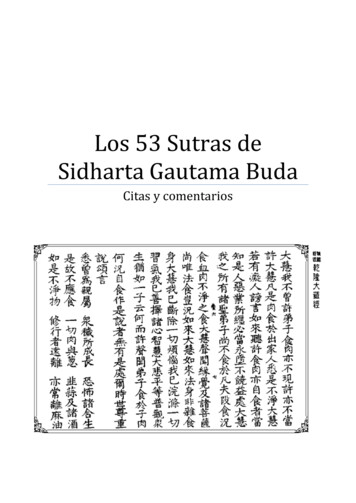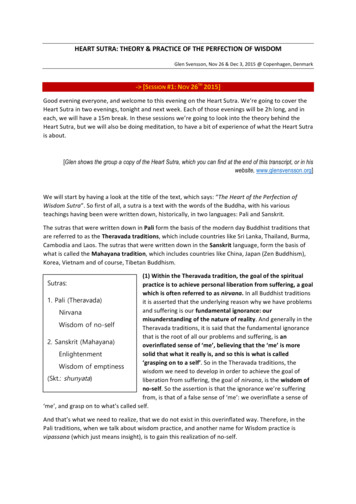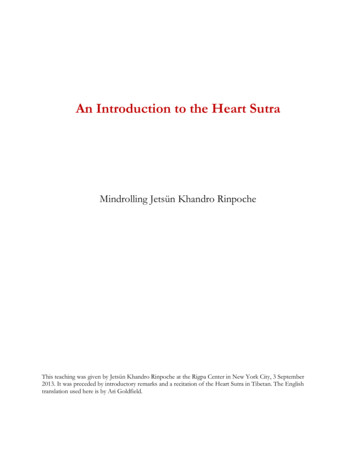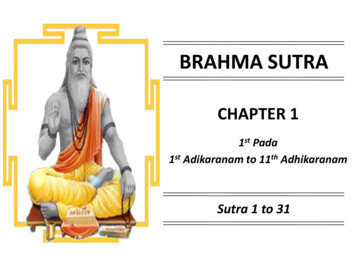
Transcription
The Lotus SutraTranslated by Burton WatsonIncludingRev. Shokai Kanai'sLectures on the Lotus Sutra1
Table of Contents1 Introduction.2 Hoben.3 Parable.4 Faith.5 Herbs.6 Assure Buddha .7 Parable.8 Buddha Disciples .9 Future Buddha Sravakas .10 Teacher.11 Stupa.12 Devadatta.13 Keeping Sutra . .14 Peaceful Practices.15 Underground.16 Life of Buddha .17 Merits.18 Rejoices at Hearing.19 Merits of Teacher of Dharma .20 Never Despising Bodhisattva .21 Supernatural Powers of Buddha22 Transmission.23 Medicine King .24 Wonderful Voice.25 Avalokitesvara Bodhisattva .26 Dharanis .27 Previous Life.28 Universal Sage 81191196200203213220228232238
PrefaceThis combination of the Burton translation of the Lotus Sutra, and the commentaries ofRev. Shokai Kanai, was my idea of making the actual sutra more readable andunderstandable.I find that the translation by itself is sometimes difficult to read in context, and thecommentaries by themselves require a lot of back and forth with the Sutra, which eats uptime and energy.So I have taken the lecture notes of Rev. Kanai and integrated them as initialsummaries, footnotes, and pseudo-appendices at the end of the chapter where necessary.No changes aside from the occasional grammar and spelling alterations were made.I hope that you will find this methodology helpful.Patricia A. WhitneyAugust 11, 20103
4
Chapter One: IntroductionSUMMARYIn Chapter 1, Sakyamuni Buddha is sitting in deep meditation at the top of Mt. SacredEagle in Rajgir, India. There were gathered gods, the rich and the poor, men and women, andalso non-human beings such as deities in forms of beasts, birds, and fishes. This denotes thatthe Lotus Sutra is for all beings, not only human beings, but also for animals and plants. Itsymbolizes equality and compassion.Suddenly the Buddha emitted a ray of light from the white curls between hiseyebrows and illuminated the universe throughout the east quadrant. This means theBuddha is about to expound the sutra of the Great Vehicle (Mahayana) called the LotusFlower of the Wonderful *************************TRANSLATION TEXTThis is what I heard 1 :At one time the Buddha 2 was in Rajagriha, staying on Mount Gridhrakuta 3 .Accompanying him were a multitude of leading monks numbering twelve thousandpersons 4 . All were arhats 5 whose outflows had come to an end, who had no more earthlydesires, who had attained what was to their advantage and had put an end to the bonds ofexistence, and whose minds had achieved a state of freedom.Their names were Ajnata Kaundinya, Mahakashyapa, Uruvilvakashyapa,Gayakashyapa, Nadikashyapa, Sâriputra, Great Maudgaly yana, Mahakatyayana,1 All sutras start with this phrase. The sutras are not books written by Sakyamuni Buddha nor recorded by someone else. They aresacred words, phrases, parables transmitted from mouth to mouth for 100 to 200 years, then written down as sutras in later years.There was probably no method to write at the time of the Buddha. At that era, writing may be considered to be disrespectful to theBuddha.2 There are many Buddhas such as Sakyamuni, Taho, Amitabha, Mahavairocana and others. In this chapter, the Buddha isSakyamuni. The Sakyamuni Buddha is the only one who was born from parents as we were, drank milk as we did, ate as we did.Other Buddhas were revealed by the Sakyamuni Buddha. Without him, we do not know anything about other Buddhas.3 It is also called Mt. Sacred Eagle or Vulture Peak. The top of the mountain looks like a head of an eagle.4 Hindu often uses numbers like 4, 8, 9 as perfect numbers. Four represent front, back, left, and right; 8 means the preceding fourplus the four corners; and 9 symbols the preceding eight plus the center. A number multiplied by 4, 8, or 9 means a lot of .5 Arhat : One who is free from all sufferings and illusions. Those who have listened to the Buddha for over 40 years and improvedthemselves spiritually. It is now ready for them to step farther to listen to the Lotus Sutra. Although they are awaken from illusions,they do not know how to lead others to the supreme teachings of the Lotus Sutra.1
Aniruddha, Kapphina, Gavampati, Revata, Pilindavatsa, Bakkula, Mahakaushthila, Nanda, 6Sundarananda, Purna Maitrayaniputra, Subhuti, Ananda, 7 and Rahula. 8 All were like these,great Arhats who were well known to others.There were also two thousand persons, some of whom were still learning and some whohad completed their learning.There was the nun Mahaprajapati 9 with her six thousand followers. And there wasRahula's mother, the nun Yashodhara, 10 with her followers.There were bodhisattvas and mahasattvas 11 , eighty thousand of them, none of themever regressing in their search for anuttara-samyaksambodhi 12 . All had gained dharanis,delighted in preaching, were eloquent, and turned the wheel of the Law 13 that knows noregression. They had made offerings to immeasurable hundreds and thousands of Buddhas, inthe presence of various Buddhas had planted numerous roots of virtue, had been constantlypraised by the Buddhas, had trained themselves in compassion, were good at entering theBuddha wisdom, and had fully penetrated the great wisdom and reached the farther shore. 14Their fame had spread throughout immeasurable worlds and they were able to save countlesshundreds of thousands of living beings.Their names were Bodhisattva 15 Manjushri, Bodhisattva Perceiver of the World'sSounds, Bodhisattva Gainer of Great Authority, Bodhisattva Constant Exertion, BodhisattvaNever Resting, Bodhisattva Jeweled Palm, Bodhisattva Medicine King, Bodhisattva BraveDonor, Bodhisattva Jeweled Moon, Bodhisattva Moonlight, Bodhisattva Full Moon,Bodhisattva Great Strength, Bodhisattva Immeasurable Strength, Bodhisattva Transcendingthe Threefold World, Bodhisattva Bhadrapala, Bodhisattva Maitreya, Bodhisattva Jeweled6 Nanda Sakyamuni Buddha's half younger brother7 Ananda Sakyamuni Buddha's cousin8 Rahula Sakyamuni Buddha's son9 Maha-Prajapati Bhiksuni Sakyamuni Buddha's adoptive mother10 Yasodhara Bhiksuni Sakyamuni Buddha's wife11 Maha - means great, chief, representative of the group12 Anuttara-samyak-sambodhi Buddha's Wisdom13 Wheel of Dharma : The Wheel of the Dharma signifies the Buddha's teachings, the Dharma is transmitted from the Buddha to A,from A to B, from B to C, and so on. The teachings are transmitted from one to another just like an eternally turning wheel.The Wheel of the Dharma is a symbol of Buddhism. The wheel has eight spokes which represent: Right View, Right Thought, RightSpeech, Right Conduct, Right livelihood, Right Endeavor, Right Mindfulness and Right Meditation.14 The Other Shore : This Shore represents the Saha World - here sentient beings live, here life is filled with suffering. There is anendless cycle of birth and death in this world. On the other hand, the other shore denotes the Buddha-land where there is nosuffering. It also refers to the land of Nirvana where the cycle of birth and death does not exist.The other shore is Hi-gan in Japanese. Higan is a memorial service in which we express our appreciation to our ancestors. It is heldtwice a year at the time of spring and autumn equinoxes. It denotes the Buddha's teaching of the MIDDLE WAY (chu - not toexceed one way or the other).15 Bodhisattva : A Bodhisattva is a person who seeks enlightenment not only for himself but also for others. A Bodhisattva is afuture Buddha.2
Accumulation, and Bodhisattva Guiding Leader. Bodhisattvas and mahasattvas such asthese numbering eighty thousand were in attendance.At that time Shakra Devanam Indra with his followers, twenty thousand sons of gods 16 ,also attended. There were also the sons of gods Rare Moon, Pervading Fragrance, JeweledGlow, and the Four Great Heavenly Kings, along with their followers, ten thousand sons ofgods.Present were the sons of gods Freedom and Great Freedom and their followers, thirtythousand sons of gods, Present were King Brahma, lord of the saha world, the great BrahmaShikhin, and the great Brahma Light Bright, and their followers, twelve thousand sons ofgods.There were eight dragon kings 17 , the dragon king Nanda, the dragon king Upananda,the dragon king Sagara, the dragon king Vasuki, the dragon king Takshaka, the dragon kingAnavatapta, the dragon king Manasvin, the dragon king Utpalaka, each with severalhundreds of thousands of followers.There were four kimnara kings 18 , the kimnara king Great Law, and the kimnara kingUpholding the Law, each with several hundreds of thousands of followers.There were four gandharva kings 19 , and gandharva king Pleasant, the gandharva kingPleasant Sound, the gandharva Beautiful Sound, each with several hundreds of thousands offollowers.There were four asura kings, the asura king Balin, the asura king Kharaskandha, theasura king Vemachitrin, and the asura king Rahu, each with several hundreds of thousands offollowers.There were four garuda kings, 20 the garuda king Great Majesty, the garuda kingGreat Body, the garuda king Great Fullness, and the garuda king As One Wishes, each withseveral hundreds of thousands of followers. And there was King Ajatashatru, 21 the son ofVaidehi, with several hundreds of thousands of followers.16 Gods : In Buddhism, gods are subject of cycle of birth and death. They are protective deities that must follow the law of theDharma (Myo-ho), they also support the practitioners of the Lotus Sutra.17 dragon-kings : All beings living in the oceans, rivers and water; such as fish.18 kimnara-kings : Practitioners of Dharma19 gandharva-kings : Musicians who serve the protective gods asura-kings. Demons who fly in the sky and harm human beings.Even demons adore the teachings of the Buddha.20 garuda-king : All beings who fly in sky like birds21 King Ajatasatru : The son of King Bimbisara and Queen Vaidehi. When King Ajatasatru was the crowned prince, he imprisonedhis father and mother. Through the instigation of Devadatta (who was the cousin of Sakyamuni Buddha), Ajatasatru later killed his3
Each of these, after bowing in obeisance before the Buddha's feet, 22 withdrew andtook a seat to one side.At that time the World-Honored One, surrounded by the four kinds of believers, 23received offerings and tokens of respect and was honored and praised. And for the sake of thebodhisattvas he preached the Great Vehicle sutra entitled Immeasurable Meanings, a Law toinstruct the bodhisattvas, one that is guarded and kept in mind by the Buddhas.When the Buddha had finished preaching this Sutra, he sat with his legs crossed inlotus position and entered into the samadhi of the place of immeasurable meanings, his bodyand mind never moving. At that time heaven rained down mandarava flowers, greatmandarava flowers, manjushaka flowers, and great manjushaka flowers, scattering them overthe Buddha and over the great assembly, and everywhere the Buddha world quaked andtrembled in six different ways.At that time the monks, nuns, laymen, laywomen, heavenly beings, dragons, yakshas,gandharvas, asuras, garudas, kimnaras, mahoragas, human and nonhuman beings in theassembly, as well as the petty kings and wheel-turning sage kings - all those in the greatassembly, having gained what they had never had before, were filled with joy and, pressingtheir palms together, gazed at the Buddha with a single mind.At that time the Buddha emitted a ray of light from the tuft of white hair between hiseyebrows, one of his characteristic features, lighting up eighteen thousand worlds in theeastern direction. There was no place that the light did not penetrate, reaching downward asfar as the Avichi hell and upward to the Akanishtha heaven.From this world one could see the living beings in the six paths of existence in all ofthose other lands. One could likewise see the Buddhas present at that time in those otherlands and could hear the sutra teachings that those Buddhas were expounding. At the sametime one could see the monks, nuns, laymen, and laywomen who had carried out religiouspractices and attained the way. One could also see the bodhisattvas and mahasattvas who,through various causes and conditions and various types of faith and understanding and invarious forms and aspects were carrying out the way of the bodhisattva. And one could alsofather and took the throne of the Kingdom. Ajatasatru represents evil human beings together with Devadatta. However, KingAjatasatru repented his wrong behavior and eventually embraced faith in the Lotus Sutra.22 worshipped the feet of the Buddha : It is one of customs in India to show respect to the nobility. During Buddhist services, priestsand monks bow deeply touching their foreheads on the floor and their palms of hands facing up. This action is to receive Buddha'sfeet on their palms indicating high respect to the Buddha.23 the four kind of devotees : They are bhiksus (priests), bhiksunis (nuns), upasakas (laymen), and upasikas (lay-women)4
see the Buddhas who had entered parinirvana, towers adorned with the seven treasures wereerected for the Buddha relics.At that time the Bodhisattva Maitreya had this thought: Now the World-HonoredOne has manifested these miraculous signs. But what is the cause of these auspiciousportents? Now the Buddha, the World Honored One, has entered into samadhi. Anunfathomable event such as this is seldom to be met with. Whom shall I question about this?Who can give me an answer?And again he had this thought: this Manjushri, son of a Dharma King, has alreadypersonally attended and given offerings to immeasurable numbers of Buddhas in the past.Surely he must see these rare signs. I will now question him.At this time the monks, nuns, laymen and laywomen, as well as the heavenly beings,dragons, spirits, and the others all had this thought: this beam of brightness from the Buddha,these signs of transcendental powers - now whom shall we question about them?At that time Bodhisattva Maitreya wished to settle his doubts concerning the matter.And in addition he could see what was in the minds of the four kinds of believers, the monks,nuns, laymen and laywomen, as well as the heavenly beings, dragons, spirits and the otherswho made up the assembly. So he questioned Manjushri, saying, "What is the cause of theseauspicious portents, these signs of transcendental powers, this emitting of a great beam ofbrightness that illumines the eighteen thousand lands in the eastern direction so we can seeall the adornments of the Buddha worlds there?"Then Bodhisattva Maitreya, wishing to state his meaning once more, asked thequestion in verse form:Manjushri,Why from the white tuft between the eyebrows of our leader and teacher does thisgreat light shine all around?Why do mandarava and manjushaka flowers rain down and breezes scented withsandalwood delight the hearts of the assembly?Because of these the earth is everywhere adorned and purified and this world quakesand trembles in six different ways.At this time the four kinds of believers are all filled with joy and delight, they rejoicein body and mind, having gained what they never had before.The beam of brightness from between the eyebrows illumines the eastern directionand eighteen thousand lands are all the color of gold.From the Avichi hell upward to the Summit of Being, throughout the various worldsthe living beings in the six paths,the realm to which their births and deaths are5
tending,their good and bad deeds,and the pleasing or ugly recompense theyreceive - all these can be seen from here.We can also see Buddhas, those sage lords, lions, expounding and preaching sutrasthat are subtle, wonderful and foremost.Their voices are clear and pure, issuing in soft and gentle sounds, as they teachbodhisattvas in numberless millions.Their Brahma sounds are profound and wonderful, making people delight in hearingthem.Each in his own world preaches the correct Law, following various causes andconditions and employing immeasurable similes, illuminating the Law of theBuddha, guiding living beings to enlightenment.If a person should encounter troubles, loathing old age, sickness and death, theBuddhas preach to him on nirvana, explaining how he may put an end to alltroubles.If a person should have good fortune, having in the past made offerings to theBuddhas, determined to seek a superior Law, the Buddhas preach the way ofthe pratyekabuddha.If there should be Buddha sons who carry out various religious practices, seeking toattain the unsurpassed wisdom, the Buddhas preach the way of purity.Manjushri, I have been dwelling here, seeing and hearing in this manner many thingsnumbering in the thousands of millions.Numerous as they are, I will now speak of them in brief.I see in these lands bodhisattvas numerous as Ganges sands, according with variouscauses and conditions and seeking the way of the Buddha.Some of them give alms, gold, silver, coral, pearls, mani jewels, seashell, agate,diamonds and other rarities, men and women servants, carriages, jeweled handcarriages and palanquins, gladly presenting these donations.Such gifts they give to the Buddha way, desiring to achieve the vehicle that isforemost in the threefold world and praised by the Buddhas.There are some bodhisattvas who give jeweled carriages drawn by teams of four, withrailings and flowered canopies adorning their top and sides.Again I see bodhisattvas who give their own flesh, hands and feet, or their wives andchildren, seeking the unsurpassed way.I also see bodhisattvas who happily give heads, eyes, bodies and limbs in their searchfor the Buddha wisdom.Manjushri, I see kings going to visit the place of the Buddha to ask him about theunsurpassed way.They put aside their happy lands, their palaces, their men and women attendants,shave their hair and beard and don the clothes of the Dharma.6
Or I see bodhisattvas who become monks, living alone in quietude, delighting inchanting the sutras.Again I see bodhisattvas bravely and vigorously exerting themselves, entering thedeep mountains, their thoughts on the Buddha way.And I see them removing themselves from desire, constantly dwelling in emptinessand stillness, advancing deep into the practice of mediation until they havegained the five transcendental powers.And I see bodhisattvas resting in meditation, palms pressed together, with a thousand,ten thousand verses praising the king of the doctrines.Again I see bodhisattvas, profound in wisdom, firm in purpose, who know how toquestion the Buddhas and accept and abide by all they hear.I see Buddha sons proficient in both meditation and wisdom, who use immeasurablenumbers of similes to expound the Law to the assembly, delighting inpreaching the Law, converting the bodhisattvas, defeating the legions of thedevil and beating the Dharma drum.And I see bodhisattvas profoundly still and silent, honored by heavenly beings anddragons but not counting that a joy.And I see bodhisattvas living in forests, emitting light, saving those who suffer in hell,causing them to enter the Buddha way.And I see Buddha sons who have never once slept, who keep circling through theforest diligently seeking the Buddha way.And I see those who observe the precepts, no flaw in their conduct, pure as jewels andgems, and in that manner seeking the Buddha way.And I see Buddha sons abiding in the strength of fortitude, taking the abuse and blowsof persons of overbearing arrogance, willing to suffer all these, and in thatmanner seeking the Buddha way.I see bodhisattvas removing themselves form frivolity and laughter and from foolishcompanions, befriending persons of wisdom, unifying their minds, dispellingconfusion, ordering their thoughts in mountain and forest for a million, athousand, ten thousand years in that manner seeking the Buddha way.Or I see bodhisattvas with delicious things to eat and drink and a hundred kinds ofmedicinal potions, offering them to the Buddha and his monks; fine robes andsuperior garments costing in the thousands or ten thousands, or robes that arebeyond cast, offering them to the Buddha and his monks; a thousand, tenthousand, a million kinds of jeweled dwellings made of sandalwood andnumerous wonderful articles of bedding, offering them to the Buddha and hismonks; immaculate gardens and groves where flowers and fruit abound,flowing springs and bathing pools, offering them to the Buddha and his monks;offerings of this kind, or many different wonderful varieties presented gladlyand without regret as they seek the unsurpassed way.7
Or there are bodhisattvas who expound the Law of tranquil extinction, givingdifferent types of instruction to numberless living beings.Or I see bodhisattvas viewing the nature of all phenomena as having no dualcharacteristics, as being like empty space.And I see Buddha sons whose minds have no attachments, who use this wonderfulwisdom to seek the unsurpassed way.Manjushri, there are also bodhisattvas who after the Buddha has passed intoextinction make offerings to his relics.I see Buddha sons building memorial towers as numberless as Ganges sands,ornamenting each land with them, jeweled towers lofty and wonderful, fivethousand yojanas high, their width and depth exactly two thousand yojanas,each of these memorial towers with its thousand banners and streamers, withcurtains laced with gems like dewdrops and jeweled bells chimingharmoniously.There are heavenly beings, dragons, spirits, human and nonhuman beings, withincense, flowers and music constantly making offerings.Manjushri, these Buddha sons in order to make offerings to the relics adorn thememorial towers so that each land, just as it is, is as outstandingly wonderfuland lovely as the heavenly king of trees when its flowers open and unfold.When the Buddha emits a beam of light I and the other members of the assembly cansee these lands in all their various outstanding wonders.The supernatural powers of the Buddhas and their wisdom are rare indeed; byemitting one pure beam of light, the Buddhas illuminate countless lands.I and the others have seen this, have gained something never known before.Buddha son, Manjushri, I beg you to settle the doubts of the assembly.The four kinds of believers look up in happy anticipation, gazing at you and me.Why does the World-Honored One emit this beam of brightness?Buddha son, give a timely answer, settle these doubts and occasion joy!What rich benefits will come from the projecting of this beam of brightness?It must be that the Buddha wishes to expound the wonderful Law he gained when hesat in the place of practice.He must have prophecies to bestow. He has showed us Buddha lands with theiradornment and purity of manifold treasures, and we have seen their Buddhas this is not done for petty reasons.Manjushri, you must know.The four kinds of believers, the dragons and spirits gaze at you in surmise, wonderingwhat explanation you will give.8
At that time Manjushri said to the bodhisattva and mahasattva Maitreya and theother great men: "Good men, I suppose that the Buddha, the World Honored One, wishes nowto expound the great Law, to rain down the rain of the great Law, to blow the conch of thegreat Law, to beat the drum of the great Law, to elucidate the meaning of the great Law.Good men, in the past I have seen this auspicious portent among the Buddhas. They emitted abeam of light like this, and after that they expounded the great Law. Therefore we shouldknow that now, when the present Buddha manifests this light, we will do likewise. He wishesto cause all living beings to hear and understand the Law, which is difficult for all the worldto believe. Therefore he has manifested this auspicious portent."Good men, once, at a time that was an immeasurable, boundless, inconceivablenumber of asamkhya kalpas in the past, there was a Buddha named Sun Moon Bright, ThusCome One, worthy of offerings, of right and universal knowledge, perfect clarity andconduct, well gone, understanding the world, unexcelled worthy, trainer of people, teacher ofheavenly and human beings, Buddha, World-Honored One, who expounded the correctLaw. His exposition was good at the beginning, good in the middle, good at the end. Themeaning was profound and far-reaching; the words were skillful and wondrous. It was pureand without alloy, complete, clean and spotless, and bore the marks of Brahma practice.""For the sake of those seeking to become voice-hearers he responded by expoundingthe Law of the four noble truths, 24 so that they could transcend birth, old age, sickness anddeath and attain nirvana. For the sake of those seeking to become pratyekabuddhas heresponded by expounding the Law of the twelve-linked chain of causation. 25 For the sake ofthe bodhisattvas he responded by expounding the six paramitas 26 , causing them to gainanuttara-samyak-sambodhi and to acquire the wisdom that embraces all species.""Then there was another Buddha who was also named Sun Moon Bright, and thenanother Buddha also named Sun Moon Bright. There were twenty thousand Buddhas like24 THE FOUR (NOBLE) TRUTHS:A basic concept in Buddhism which explains the cause of suffering and the way of freedom from them.1. ALL EXISTENCE IS SUFFERING : This world is full of sufferings. Life is full of dissatisfaction; if we do not have enough money, wesuffer; if we have more than enough money, we still worry about not losing it.2. THE CAUSE OF SUFFERING IS ILLUSION AND DESIRE : There are so many people dying everyday. If we do not know them,we do not feel sad but if we know them, we grieve. It is because we have desire for them to live long.3. NIRVANA IS THE REALM FREE FROM SUFFERINGS : Peace of mind can be attained after we eliminate all sufferings ordissatisfactions.4. THE WAYS FOR THE ATTAINMENT OF NIRVANA IS TO PRACTICE EIGHT FOLD PATHS:They are: Right View, Right Thought, Right Speech, Right Conduct, Right Livelihood, Right Endeavor, Right Mindfulness andRight Meditation.25 TWELVE CAUSES (the Twelve-linked chain of dependent origination) : Ignorance (moo-my), Action (go), Consciousness(shake), Mental functions and matter (my-shake), the Six senses (rook-nigh), Contact (soak), Perception (dg), Desire (AI),Attachment (Hs), Existence (u), Birth (Hs), and Old age and death (ro-shi).26 SIX PARAMITAS : The six kinds of practice by which Bodhisattvas are able to attain Enlightenment. They are : Donation (fuse),Keeping Precepts (ji-kai), Perseverance (nin-niku), Endeavor (Sho-jin), Meditation (zen-jo), and Wisdom (Chi-e).9
this, all with the same appellation, all named Sun Moon Bright. And all had the samesurname, the surname Bharadvaja. Maitreya, you should understand that from the firstBuddha to the last, all had the same appellation; all were named Sun Moon Bright. Theywere worthy of all the ten epithets 27 and the Law they expounded was good at thebeginning, in the middle, and at the end.""The last Buddha, when he had not yet left family life, had eight princely sons. The firstwas named Having Intention, the second Good Intention, the third Immeasurable Intention,the fourth Jeweled Intention, the fifth Increased Intention, the sixth Cleansed of DoubtIntention, the seventh Echoing Intention, and the eighth Law Intention. Dignity and virtuecame easily to them, and each presided over a four-continent realm.""When these princes heard that their father had left family life and had gainedanuttara-samyak-sambodhi, they all cast aside their princely positions and followed him byleaving family life. Conceiving a desire for the Great Vehicle, the constantly carried outBrahma practices, and all became teachers of the Law. They had already planted good rootsin the company of a thousand, ten thousand Buddhas.""At that time the Buddha Sun Moon Bright preached the Great Vehicle sutra entitledImmeasurable Meanings, a Law to instruct the Bodhisattvas, one that is guarded and kept inmind by the Buddhas. When he had finished preaching the sutra, he sat cross-legged in themidst of the great assembly and entered into the samadhi of the place of immeasurablemeanings, his body and mind never moving. At this time heaven rained down mandaravaflowers, great mandarava flowers, manjushaka flowers, and great manjushaka flowers,scattering them over the Buddha and the great assembly, and everywhere the Buddha worldquaked and trembled in six different ways.""At that time the monks, nuns, laymen and laywomen , heavenly beings, dragons,yakshas, gandharvas, asuras, garudas, kimnaras, and mahoragas, the human and nonhumanbeings in the assembly, as well as the petty kings and wheel-turning sage kings - all those inthis great assembly gained what they had never had before and, filled with joy, pressed theirpalms together and gazed at the Buddha with a single mind.27 THE TEN EPITHETS OF THE BUDDHATathagata: one who has come from the world of truth.Deserver of Offerings: one who deserves oblations.Perfectly Enlightened One: one who knows everything perfectly.Man of Wisdom and Practice: one who sees the truth and walks the way satisfactorily.Well-Gone: one who is gone to the world of enlightenment.Knower of the World: one who understands the world.Unsurpassed Man: one who is not surpassed by anyone.Instructor of Men: one who trains or instructs men.Teacher of Gods and Men: one who teaches gods and men.World-Honored One: one who is honored by the people of the world.10
"At that time the Thus Come One emitted a ray of light from the tuft of white hairbetween his eyebrows, one of his characteristic features, lighting up eighteen thousandBuddha lands in the eastern direction. There was no place that the light did not penetrate,just as you have seen it light up these Buddha lands now.""Maitreya, you should understand this. At that time in the assembly there were twentymillion bodhisattvas who were happy and eager to hear the Law. When these bodhisattvassaw this beam of light tha
lotus position and entered into the samadhi of the place of immeasurable meanings, his body and mind never moving. At that time heaven rained down mandarava flowers, great mandarava flowers, manjushaka flowers, and great manjushaka flowers, scattering them over the Buddha and over the great assembly, and everywhere the Buddha world quaked and









